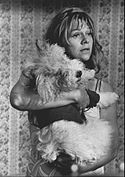Oscaruddelingen 1968
| Oscaruddelingen 1968 | |
|---|---|
| Dato | 10. april 1968 (oprindeligt planlagt til 8. april) |
| Sted | Santa Monica Civic Auditorium, Santa Monica |
| Vært | Bob Hope |
| Producer | Arthur Freed |
| Instruktør | Richard Dunlap |
| Priser | |
| Bedste film | I nattens hede |
| Flest priser | I nattens hede (5) |
| Flest nomineringer | Bonnie and Clyde og Gæt hvem der kommer til middag (10) |
| Oscaruddelingen | |
| Foregående | 1967 |
| Efterfølgende | 1969 |
Oscaruddelingen 1968 var den 40. oscaruddeling, hvor de bedste film fra 1967 blev hædret af Academy of Motion Picture Arts and Sciences. Oprindeligt planlagt til 8. april 1968, men blev udskudt to dage på grund af mordet af Martin Luther King Jr. så uddelingen blev afholdt 10. april 1968 i Santa Monica Civic Auditorium, Santa Monica, Californien, USA. Bob Hope var igen vært for ceremonien.





Priser
Vinderne står øverst i fed skrift og (![]() ).[1]
).[1]
| Bedste film | Bedste instruktør |
|---|---|
|
|
| Bedste mandlige hovedrolle | Bedste kvindelige hovedrolle |
|
|
| Bedste mandlige birolle | Bedste kvindelige birolle |
|
|
| Bedste Originale Manuskript | Bedste Filmatisering |
|
|
| Bedste udenlandske film | Bedste dokumentarfilm |
|
|
| Bedste kortdokumentar | Best Live Action Short Subject |
|
|
| Bedste Korte Animationsfilm | Bedste Originale Musik |
|
|
| Bedste Bearbejdede Musik | Bedste sang |
|
|
| Bedste kostumer | Bedste scenografi |
|
|
| Bedste fotografering | Bedste lyd |
|
|
| Bedste lydeffekter | Bedste klipning |
|
|
| Bedste visuelle effekter | |
|
Kilder
- ^ "The 40th Academy Awards (1968) Nominees and Winners". oscars.org. Arkiveret fra originalen 2014-11-03. Hentet 2011-11-10.
Eksterne henvisninger
- Oscaruddelingen 1968 på Internet Movie Database (engelsk)
Medier brugt på denne side
Forfatter/Opretter: RexxS, Licens: CC0
A double-dagger symbol for use in in-line text, so that alt text can be applied, for compatibility with screen readers. This version has no anti-aliasing, which may produce a cleaner effect at this small size.
Photo of George Kennedy from the short-lived television show "Sarge". Kennedy played a tough cop who decides to quit law enforcement and enter the priesthood.
Forfatter/Opretter: Kingkongphoto & www.celebrity-photos.com from Laurel Maryland, USA, Licens: CC BY-SA 2.0
From PBS celebration on mall May 27, 1995 Washington D..C.
© copyright John Mathew Smith 2001Guest artist Elmer Bernstein conducts the United States Air Force Band in the last of a series of spring concerts at Constitution Hall.
Photo of Estelle Parsons from an episode of Love, American Style.





